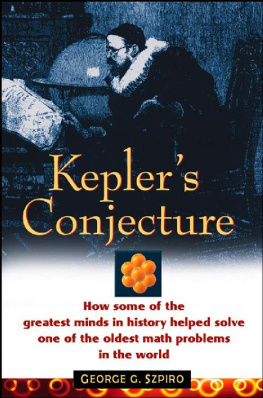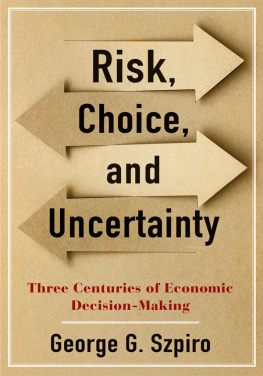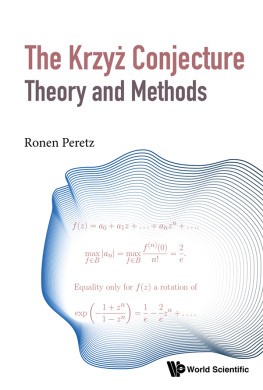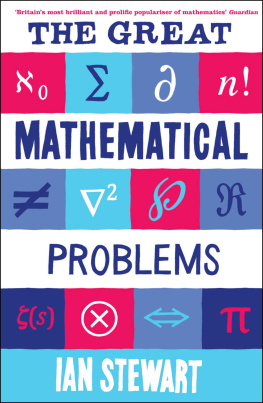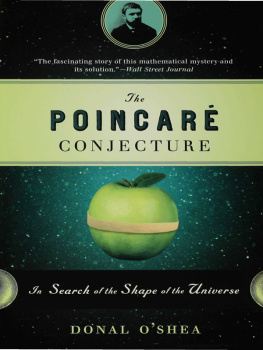George G. Szpiro - Kepler’s Conjecture: How Some of the Greatest Minds in History Helped Solve One of the Oldest Math Problems in the World
Here you can read online George G. Szpiro - Kepler’s Conjecture: How Some of the Greatest Minds in History Helped Solve One of the Oldest Math Problems in the World full text of the book (entire story) in english for free. Download pdf and epub, get meaning, cover and reviews about this ebook. City: Hoboken (N.J.), year: 2003, publisher: John Wiley and Sons, genre: Religion. Description of the work, (preface) as well as reviews are available. Best literature library LitArk.com created for fans of good reading and offers a wide selection of genres:
Romance novel
Science fiction
Adventure
Detective
Science
History
Home and family
Prose
Art
Politics
Computer
Non-fiction
Religion
Business
Children
Humor
Choose a favorite category and find really read worthwhile books. Enjoy immersion in the world of imagination, feel the emotions of the characters or learn something new for yourself, make an fascinating discovery.
- Book:Kepler’s Conjecture: How Some of the Greatest Minds in History Helped Solve One of the Oldest Math Problems in the World
- Author:
- Publisher:John Wiley and Sons
- Genre:
- Year:2003
- City:Hoboken (N.J.)
- Rating:4 / 5
- Favourites:Add to favourites
- Your mark:
- 80
- 1
- 2
- 3
- 4
- 5
Kepler’s Conjecture: How Some of the Greatest Minds in History Helped Solve One of the Oldest Math Problems in the World: summary, description and annotation
We offer to read an annotation, description, summary or preface (depends on what the author of the book "Kepler’s Conjecture: How Some of the Greatest Minds in History Helped Solve One of the Oldest Math Problems in the World" wrote himself). If you haven't found the necessary information about the book — write in the comments, we will try to find it.
George G. Szpiro: author's other books
Who wrote Kepler’s Conjecture: How Some of the Greatest Minds in History Helped Solve One of the Oldest Math Problems in the World? Find out the surname, the name of the author of the book and a list of all author's works by series.
Kepler’s Conjecture: How Some of the Greatest Minds in History Helped Solve One of the Oldest Math Problems in the World — read online for free the complete book (whole text) full work
Below is the text of the book, divided by pages. System saving the place of the last page read, allows you to conveniently read the book "Kepler’s Conjecture: How Some of the Greatest Minds in History Helped Solve One of the Oldest Math Problems in the World" online for free, without having to search again every time where you left off. Put a bookmark, and you can go to the page where you finished reading at any time.
Font size:
Interval:
Bookmark:
KEPLERS CONJECTURE
How Some of the Greatest Minds in History
Helped Solve One of the Oldest
Math Problems in the World
George G. Szpiro
WILEY
John Wiley & Sons, Inc.
Copyright 2003 by George G. Szpiro. All rights reserved
Published by John Wiley & Sons, Inc., Hoboken, New Jersey
Published simultaneously in Canada
Illustrations on pp. 4, 5, 8, 9, 23, 25, 31, 32, 34, 45, 47, 50, 56, 60, 61, 62, 66, 68, 69, 73, 74, 75, 81, 85, 86, 109, 121, 122, 127, 130, 133, 135, 138, 143, 146, 147, 153, 160, 164, 165, 168, 171, 172, 173, 187, 188, 218, 220, 222, 225, 226, 228, 230, 235, 236, 238, 239, 244, 245, 246, 247, 249, 250, 251, 253, 258, 259, 261, 264, 266, 268, 269, 274, copyright 2003 by Itay Almog. All rights reserved
Photos pp. 12, 37, 54, 77, 100, 115 Niderschsische Staats- und Universittsbibliothek, Gttingen; p. 52 Department of Mathematics, University of Oslo; p. 92 AT&T Labs; p. 224 Denis Weaire
Library of Congress Cataloging-in-Publication Data:
Szpiro, George, date.
Keplers conjecture: how some of the greatest minds in history helped solve one of the oldest math problems in the world / by George Szpiro.
p. cm.
Includes bibliographical references and index.
ISBN 0-471-08601-0 (cloth : acid-free paper)
1. MathematicsPopular works. I. Title.
QA93 .S97 2002
510dc21
Contents
This book describes a problem that has vexed mathematicians for nearly four hundred years. In 1611, the German astronomer Johannes Kepler conjectured that the way to pack spheres as densely as possible is to pile them up in the same manner that greengrocers stack oranges or tomatoes. Until recently, a rigorous proof of that conjecture was missing.
It was not for lack of trying. The best and the brightest attempted to solve the problem for four centuries. Only in 1998 did Tom Hales, a young mathematician from the University of Michigan, achieve success. And he had to resort to computers. The time and effort that scores of mathematicians expended on the problem is truly surprising. Mathematicians routinely deal with four and higher dimensional spaces. Sometimes this is difficult; it often taxes the imagination. But at least in three-dimensional space we know our way around. Or so it seems. Well, this isnt so, and the intellectual struggles that are related in this book attest to the immense difficulties. After Simon Singh published his bestseller on Fermats problem, he wrote in New Scientist that a worthy successor for Fermats Last Theorem must match its charm and allure. Keplers sphere-packing conjecture is just such a problemit looks simple at first sight, but reveals its subtle horrors to those who try to solve it.
I first met Keplers conjecture in 1968, as a first-year mathematics student at the Swiss Federal Institute of Technology (ETH). A professor of geometry mentioned in an unrelated context that one believes that the densest packing of spheres is achieved when each sphere is touched by twelve others in a certain manner. He mentioned that Kepler had been the first person to state this conjecture and went on to say that together with Fermats famous theorem this was one of the oldest unproven mathematical conjectures. I then forgot all about it for a few decades.
Thirty years and a few career changes later, I attended a conference in Haifa, Israel. It dealt with the subject of symmetry in academic and artistic disciplines. I was working as a correspondent for a Swiss daily, the Neue Zrcher Zeitung (NZZ). The seven-day conference turned out to be one of the best weeks of my journalistic career. Among the people I met in Haifa was Tom Hales, the young professor from the University of Michigan, who had just a few weeks previously completed his proof of Keplers conjecture. His talk was one of the highlights of the conference. I subsequently wrote an article on the conference for the NZZ, featuring Toms proof as its centerpiece. Then I returned to being a political journalist.
The following spring, while working up a sweat on my treadmill one afternoon, an idea suddenly hit. Maybe there are people, not necessarily mathematicians, who would be interested in reading about Keplers conjecture. I got off the treadmill and started writing. I continued to write for two and a half years. During that time, the second Palestinian uprising broke out and the peace process was coming apart. It was a very sad and frustrating period. What kept my spirits up in these trying times was that during the night, after the newspapers deadline, I was able to work on the book. But then, just as I was putting the finishing touches to the last chapters, an Islamic Jihad suicide bomber took the life of one my closest friends. A few days later, disaster hit New York, Washington, and Pennsylvania. If only human endeavor could be channeled into furthering knowledge instead of seeking to visit destruction on ones fellow men. Would it not be nice if newspapers could fill their pages solely with stories about arts, sports, and scientific achievements, and spice up the latter, at worst, with news on priority disputes and academic battles?
This book is meant for the general reader interested in science, scientists, and the history of science, while trying to avoid short-changing mathematicians. No knowledge of mathematics is needed except for what one usually learns in high school. On the other hand, I have tried to give as much mathematical detail as possible so that people who would like to know more about what mathematicians do will also find the book of interest. (Readers interested in knowing more about the people who helped solve Keplers conjecture and the circumstances of their work will also be able to find additional material at www.GeorgeSzpiro.com.)
Those readers more interested in the basic story may want to skip the more esoteric mathematical points; for that reason, some of the denser mathematical passages are set in a different font. Even more esoteric material is banished to appendixes. I should point out that the mathematics is by no means rigorous. My aim was to give the general idea of what constitutes a mathematical proof, not to get lost in the details. Emphasis is placed on vividness and sometimes only an example is given rather than a stringent argument.
One further math note: throughout the text, numbers are truncated after three or four digits. In the mathematical literature this is usually written as, say, 0.883.... , to indicate that many more digits (possibly infinitely many) follow. In this book I do not always add the dots after the digits.
I have found much valuable material at the Mathematics Library, the Harman Science Library and the Edelstein Library for History and Philosophy of Science, all at the Hebrew University of Jerusalem. The library of the ETH in Zrich kindly supplied some papers that were not available anywhere else, and even the library of the Israeli Atomic Energy Institute provided a hard-to-find paper. I would like to thank all those institutions. The Internet proved, as always, to be a cornucopia of much useful information... and of much rubbish. For example, under the heading On Johannes Keplers Early Life I found the following gem: There are no records of Johannes having any parents. So much for that. Separating the e-wheat from the e-chaff will probably become the most important aspect of Internet search engines of the future. One of the most useful web sites I came across during the research for this book is the MacTutor History of Mathematics archive (www-groups.dcs.st-and.ac.uk/history), maintained by the School of Mathematics and Statistics of the University of Saint Andrews in Scotland. It stores a collection of biographies of about 1,500 mathematicians.
Friends and colleagues read parts of the manuscript and made suggestions. I mention them in alphabetical order. Among the mathematicians and physicists who offered advice and explanations are Andras Bezdek, Benno Eckmann, Sam Ferguson, Tom Hales, Wu-Yi Hsiang, Robert Hunt, Greg Kuperberg, Wlodek Kuperberg, Jeff Lagarias, Christoph Lthy, Robert MacPherson, Luigi Nassimbeni, Andrew Odlyzko, Karl Sigmund, Denis Weaire, and Gnther Ziegler. I thank all of them for their efforts, most of all Tom and Sam, who were always ready with an e-mail clarification to any of my innumerable questions on the fine points of their proof. Thanks are also due to friends who took the time to read selected chapters: Elaine Bichler, Jonathan Dagmy, Ray and Jeanine Fields, Ies Friede, Jonathan Misheiker, Marshall Sarnat, Benny Shanon, and Barbara Zinn. Itay Almog did much more than just the artwork by correcting some errors and providing me with numerous suggestions for improvement. Special acknowledgment is reserved for my mother, who read the entire manuscript. (Needless to say, she found it fascinating.) I would also like to thank my agent, Ed Knappman, who encouraged me from the time when only a sample chapter and an outline existed, and Jeff Golick, the editor at John Wiley & Sons, who brought the manuscript into publishable form.
Next pageFont size:
Interval:
Bookmark:
Similar books «Kepler’s Conjecture: How Some of the Greatest Minds in History Helped Solve One of the Oldest Math Problems in the World»
Look at similar books to Kepler’s Conjecture: How Some of the Greatest Minds in History Helped Solve One of the Oldest Math Problems in the World. We have selected literature similar in name and meaning in the hope of providing readers with more options to find new, interesting, not yet read works.
Discussion, reviews of the book Kepler’s Conjecture: How Some of the Greatest Minds in History Helped Solve One of the Oldest Math Problems in the World and just readers' own opinions. Leave your comments, write what you think about the work, its meaning or the main characters. Specify what exactly you liked and what you didn't like, and why you think so.

